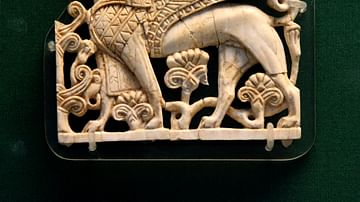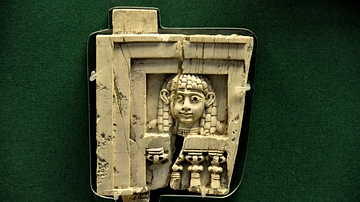Search
Remove Ads
Advertisement
Summary 
Loading AI-generated summary based on World History Encyclopedia articles ...
Search Results

Article
The Nimrud Ivories: Their Discovery & History
In 1845 CE, the archaeologist Austen Henry Layard began excavations at the ruins of the city of Nimrud in the region which is northern Iraq in the present day. Layard's expedition was part of a larger movement at the time to uncover ancient...

Article
The Nimrud Dogs
The Nimrud Dogs, five canine figurines found at the ancient Mesopotamian city of Nimrud, were only a few of the many startling finds in the region during the 19th century when expeditions were sent to corroborate biblical narratives through...

Article
Wall Reliefs: Apkallus of the North-West Palace at Nimrud
Religion is the sigh of the oppressed creature, the heart of a heartless world, and the soul of soulless conditions. It is the opium of the people. (Karl Marx, Critique of Hegel's Philosophy of Right). When it comes to religion, many people...

Definition
Kalhu / Nimrud
Kalhu (also known as Caleh, Calah, and Nimrud, in modern-day northern Iraq) was a city in ancient Mesopotamia that became the capital of the Assyrian Empire under Ashurnasirpal II (r. 884-859 BCE) who moved the central government there from...

Definition
Ancient Israelite Art
Ancient Israelite art traditions are evident especially on stamps seals, ivories from Samaria, and carvings, each with motifs connecting it to more general artistic traditions throughout the Levant. Ancient Israel, and therefore its art...

Article
Wall Reliefs: Ashurnasirpal II's War Scenes at the British Museum
The Mighty King 600 of their warriors I put to the sword and decapitated; 400 I took alive; 3,000 captives I brought forth; I took possession of the city for myself: the living soldiers, and heads to the city of Amidi the royal city, I sent...

Image
Ivory Statue from Nimrud at the Iraq Museum
This carved ivory statue was made of different ivory pieces, which were joined together. The legs are now missing. It depicts an adult Assyrian beardless male figure. He stands in a gesture of worship. It was found (by an Iraqi team in the...

Image
Woman at the Window Ivory from Nimrud
A woman looking out of a balustraded window was a popular theme in Phoenician art. This is possibly related to the goddess Astarte and ritual prostitution. This piece belongs to a large collection of the so-called "Nimrud ivories." These...

Image
Ivory Figure of Syrian Man with an Ostrich & Goat, Nimrud
This burned ivory figure, carved in the round, depicts a male figure carrying a goat on his shoulders and holding an ostrich by the neck. The depiction is very realistic; the beak of the ostrich is opened and the front wing is held upwards...

Image
Cow & Calf Ivory Motif from Nimrud
This is one of the finest examples of the so-called "cow-and-calf" motif and is the only known to date to have been carved in the distinctive style of the "Ornate Group". On the right, a cow stands and turns her head toward her suckling calf...